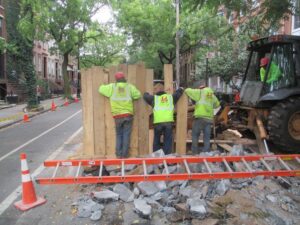A Brooklyn homeowner recently celebrated 50 years in her home when she was faced with a major sewer line problem. Over the years she had her local plumber clear the sewer line several times never thinking any additional attention was needed. Her plumber continuously removed small tree roots from the pipe after minor backups and would return to the house one to two years later. The sewer line was most recently cleared 3 months prior when the homeowner experienced another backup, and again three weeks after the most recent sewer line cleaning. The backups were occurring more frequently, the internal plumber performed a camera inspection on the pipe which showed extremely large roots he was not able to remove, in addition to several areas where the clay pipe was now separated. After appreciating the large tree in-front of her home for many years, she never thought the tree would cause her to replace the entire sewer line.
|
Roots removed from sewer |

Roots in sewer line |
Harris Water Main & Sewer Contractors provided the homeowner with two options, one was to replace the entire sewer line and the other was to replace a portion of the sewer line up to the curb. The second option is not recommended as there is no guarantee that a partial replacement will resolve the sewer backups however, cost is a primary factor that many homeowners must factor into their decision.
After weighing the pros and cons of replacing vs. repairing the pipe, the homeowner decided to avoid any risk and replace the entire sewer line. Harris Water began excavating on the property the very next day and replaced the existing clay sewer pipe with new 6” extra heavy cast iron pipe from the house to the city sidewalk. Harris made sure to have obtained all required Parks Department permits as well as having a certified arborist at the house while excavating next to the city tree. Harris had to dig by hand underneath the stoop which is very common with many brownstones in Brooklyn; the new pipe was inserted through a tunnel under the front stoop to the foundation wall. The sewer installation crew noticed that the homeowners water main was an old lead water line and was completely corroded. It was suggested to replace the water main at the same time as the sewer, the labor had already been completed and the homeowner would only be paying for the cost of material, potentially saving thousands of dollars. The DEP inspector passed partial inspection on the pipe installed before Harris backfilled the hole, in preparation for the final day of installation.

Installing pipe under stoop |
Shoring boards for protection |
Harris began opening the roadway at 8:30 AM the next morning, the city sewer was 12’ deep in the roadway which required Harris to install wood planks for shoring in the hole before the new cast iron pipe could be installed. They reached the existing clay pipe by 12Pm when they began installing the new pipe. The installation was completed by 2pm when the DEP showed up and passed final inspection on the new sewer line.
Harris Water Main & Sewer Contractors was able to assist another Brooklyn homeowner in replacing her sewer line in a time sensitive manor. The sewer installation had to be replaced on an emergency basis before the homeowner lost use of all her bathrooms and a basement apartment full of sewage.
Roots in Sewer Lines – Important Facts
Sewer lines are designed to remove waste from commercial and residential buildings however, backups occur quite often when the sewage encounters an obstruction from reaching the city sewer line. The invasion of tree roots in a sewer line is the single most common factor a homeowner will encounter when facing a sewer line backup. If the infestation of tree roots is not treated in the early stages, they may force the need for a sewer line repair or replacement. Any crack, separation or opening in a sewer line serves as a tree roots paradise; small hair like roots will sense the warm water vapors and grow toward the pipe like metal towards a magnet. Once the root reaches the pipe it will look for any cracks or crevices as an entranceway. When the small roots enter the pipe it comes in contact with all of the essential nutrients needed to survive (minerals, oxygen & water) and may grow as large as the pipe itself in some cases.
If a pre-existing root issue is not tended to in the early stages of occurrence, it may result in the need for a sewer pipe replacement. Once roots have entered the pipe they obstruct the sewage from naturally flowing on gravity from the building to the city sewer. A homeowner should maintain the entire sewer line from the house to the city sewer as it is very common for tissues and grease to get caught in the roots resulting in complete failure of the sewer line. It is important to pay attention to how your sewer line runs in the yard prior to planting any trees. You can take precautionary measures in planting trees that are known to grow slowly and place them as far from the sewer line as possible.






















